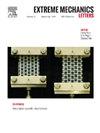Mechanics of out-of-plane screw dislocation in a 2D material
IF 4.5
3区 工程技术
Q2 MATERIALS SCIENCE, MULTIDISCIPLINARY
引用次数: 0
Abstract
We study the mechanics of out-of-plane screw dislocations in two-dimensional (2D) materials using elastic membrane theory and atomistic simulations. Through elastic membrane theory, we derive a closed-form equation for the excess energy of the out-of-plane screw dislocation, revealing that the strain associated with the dislocation in a 2D material diminishes more rapidly with distance compared to that in a bulk material. We utilize this equation to compute energy profiles of out-of-plane screw dislocations in graphene. Various core radii across Burgers vectors (i.e., number of layers) under conditions with and without hydrogen termination on the dislocation core are considered, and computed energies are validated by atomistic simulations. Our results show that the screw dislocation core has a finite core radius which increases as the Burgers vector increases to avoid a high stress concentration at the dislocation core, thereby minimizing the total energy. Furthermore, we extend our theory to include the interaction between screw dislocations in a dipole configuration. Simulation results indicate that the relaxation narrows a high-strain concentration region near the dislocation core, where the interaction energy becomes negligible. Additionally, we examine the influence of out-of-plane screw dislocations on alternating twisted multilayer graphene. Our results reveal that the screw dislocation induces additional in-plane strain on the structure near the dislocation core, but that this additional strain is confined to within 2 nm of the dislocation core.

二维材料的面外螺旋位错力学
我们利用弹性膜理论和原子模拟研究了二维材料的面外螺旋位错力学。通过弹性膜理论,我们导出了面外螺旋位错多余能量的封闭方程,揭示了与位错相关的应变在二维材料中比在块状材料中随距离的减少更快。我们利用这个方程来计算石墨烯中面外螺旋位错的能量分布。考虑了在位错核上有氢终止和没有氢终止的情况下,跨越Burgers向量的各种核半径(即层数),并通过原子模拟验证了计算的能量。结果表明,螺型位错核具有有限的核半径,核半径随着Burgers矢量的增大而增大,以避免位错核处的高应力集中,从而使总能量最小化。此外,我们扩展了我们的理论,以包括偶极位错之间的相互作用。模拟结果表明,弛豫使位错核心附近的高应变集中区域变窄,在此区域相互作用能可以忽略不计。此外,我们还研究了面外螺旋位错对交替扭曲多层石墨烯的影响。结果表明,螺旋位错会在位错核心附近的结构上产生额外的面内应变,但这种额外应变仅限于位错核心的2 nm范围内。
本文章由计算机程序翻译,如有差异,请以英文原文为准。
求助全文
约1分钟内获得全文
求助全文
来源期刊

Extreme Mechanics Letters
Engineering-Mechanics of Materials
CiteScore
9.20
自引率
4.30%
发文量
179
审稿时长
45 days
期刊介绍:
Extreme Mechanics Letters (EML) enables rapid communication of research that highlights the role of mechanics in multi-disciplinary areas across materials science, physics, chemistry, biology, medicine and engineering. Emphasis is on the impact, depth and originality of new concepts, methods and observations at the forefront of applied sciences.
 求助内容:
求助内容: 应助结果提醒方式:
应助结果提醒方式:


